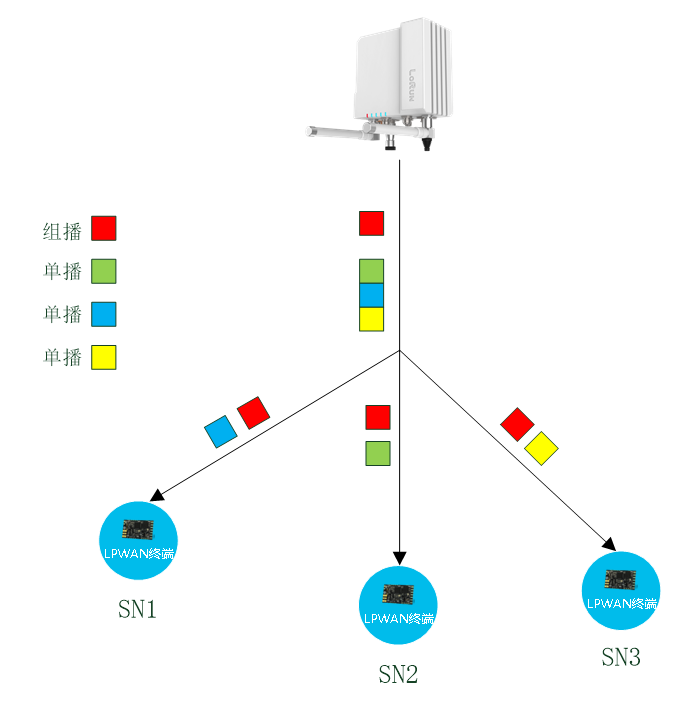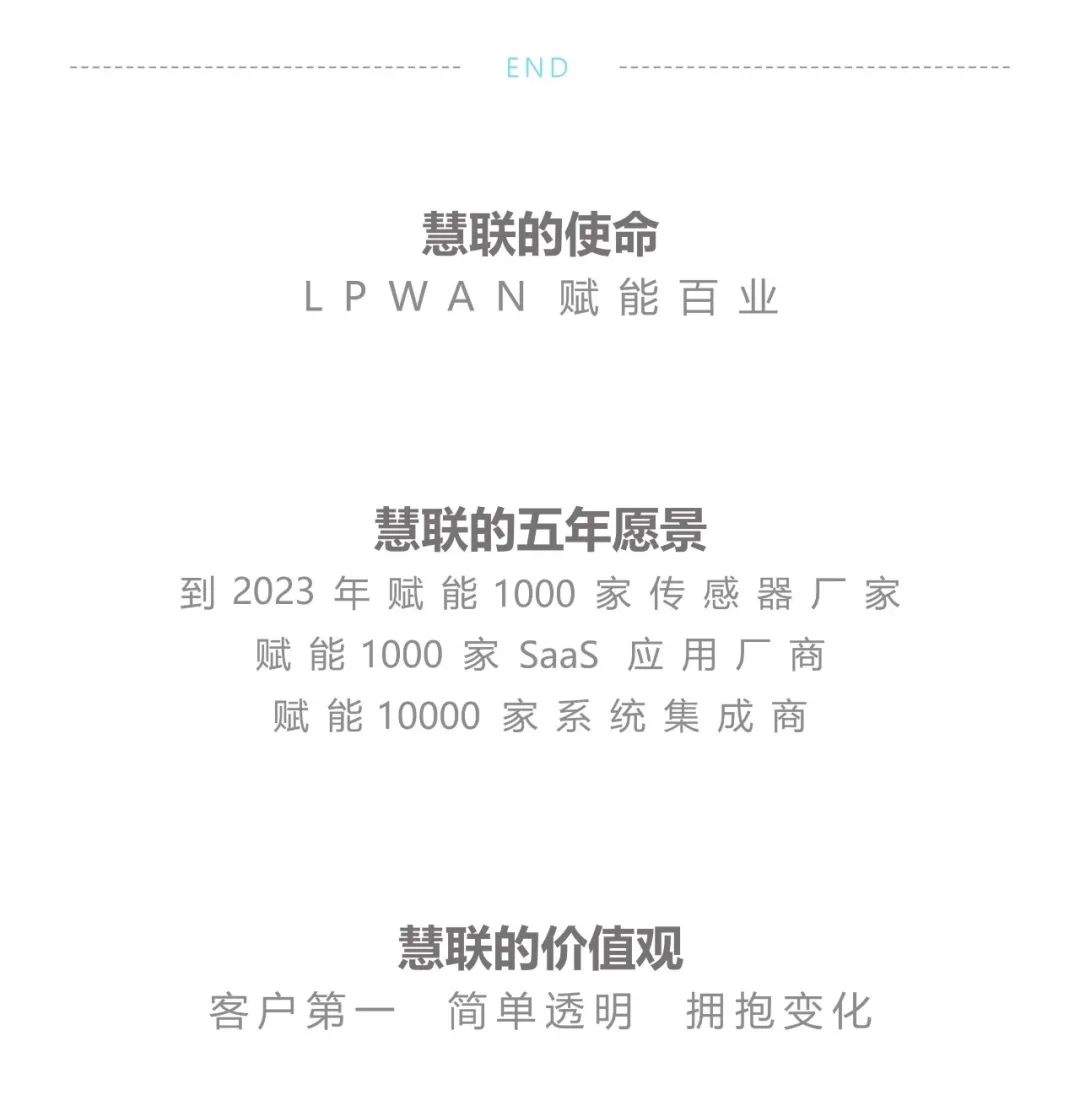The network structure of LoRaWAN application terminals (hereinafter referred to as SN) and gateways (hereinafter referred to as GW) is a star topology, where communication between SN and GW is point-to-point. Generally, a GW has 8 uplink channels and 1 downlink channel, and this capability of the GW determines that it can only send downlink messages to one SN at a time.
In applications where the frequency of downlink data is high or the data volume is large, if the gateway sends downlink messages to SN one by one, it will lead to prolonged occupation of the downlink channel, causing issues such as downlink ACK not being acknowledged due to channel blockage, and downlink commands or data failing to be sent.
Since there is only one downlink data channel and the resources are so tight, can we send the same data simultaneously to more than one SN? This is where LoRaWAN multicast technology comes into play.
1. LoRaWAN Multicast
What is multicast? Multicast is a point-to-multipoint network connection established between the sender and each receiver. If a sender transmits the same data to multiple receivers simultaneously, it only needs to copy the same data packet once. This improves data transmission efficiency, reduces the likelihood of congestion in the backbone network, and simply put, it is one-to-many communication. The LoRaWAN multicast function is only applicable to Class B/C modes, by configuring the multicast distribution window of the nodes, allowing the nodes in the group to temporarily enter Class B/C mode, and then returning to normal mode after closing the distribution window, thus enabling multicast functionality.

As shown in the figure, unicast data is sent directly from the GW to each SN point-to-point, while multicast data can be sent from the GW to multiple SNs.
2. Application Areas of Multicast
2.1 Smart Streetlights
In a smart streetlight scenario in a city, energy consumption data, abnormal status reporting, brightness control, etc., can all be implemented through the LoRaWAN protocol. In smart streetlight applications, parameters such as power consumption, current, and voltage of the streetlights will periodically send uplink data through the GW to the streetlight management platform, while brightness and switch control signals will be sent downlink from the GW to each streetlight controller. After receiving the command, the streetlight controller executes the corresponding operation. Typically, streetlight controllers operate in LoRaWAN Class C mode, meaning they do not need to enter sleep mode and are always in a state of waiting to receive downlink data.
Using the unicast downlink transmission method according to LoRaWAN Class C, streetlights can only be controlled one by one in sequence. If there are many streetlights to control, such as over two hundred, sending control commands to all of them would take at least 5 minutes. The delay is too long, leading to a poor experience; if controlling thousands of lights simultaneously, it would take nearly half an hour to complete, which is completely inadequate for timely streetlight operations. To achieve a higher frequency of dimming operations under such conditions, sequential adjustments are extremely inefficient.
In this case, if we switch to using LoRaWAN multicast to send downlink commands, we can group multiple streetlights in a block or area into the same multicast group. Then, by using the same multicast command data downlink, all streetlight controllers in the group can execute the same command simultaneously, achieving the goal of simultaneous control. This solution not only has high timeliness and a good experience but also does not affect the normal operation of other SNs in the network. Multicast will certainly promote the widespread application of LoRaWAN in smart streetlight scenarios.
2.2 Firmware Update Over The Air (FUOTA)
Typically, in a LoRaWAN network, the most troublesome issue is not the GW having problems or needing a functional upgrade. First, the GW has broadband and power supply, making it easy to locate and analyze issues remotely, and it can also be upgraded remotely. Secondly, even if remote connection is not possible, on-site maintenance is not too difficult, as the number of GWs is not very large. The challenge lies with the SNs, as they are usually numerous and may be deployed in hard-to-reach locations. If remote maintenance or functional updates are needed, it requires an enormous amount of work, time, and cost. FUOTA is designed to address this issue.
FUOTA refers to downloading firmware over the air and upgrading it. The advantages of this upgrade method are self-evident; supporting FUOTA means that the software version upgrade of the module can be completely automated wirelessly, without the need for on-site maintenance personnel to upgrade each SN individually and offline, thus saving labor costs. Before the application of the LoRaWAN multicast protocol, considering FUOTA upgrades using unicast methods was almost impossible.
A firmware package can be as small as 60KB and can exceed 100KB. Upgrading a single SN requires at least several minutes (during the upgrade process, the GW does not respond to other downlink data transmissions). If upgrading 200 SNs, the total upgrade time could exceed two days, and the GW cannot perform normal operations during the upgrade. Therefore, unicast FUOTA is not feasible.
However, using multicast protocol for FUOTA is entirely feasible. By grouping all SNs to be upgraded into one group, the firmware package can be split into several smaller packets, numbered, and sent sequentially to each SN in the group via multicast. This way, all SNs in the group can complete the download and upgrade in the time it takes to upgrade one SN, greatly improving efficiency and having almost no impact on normal operations.
2.3 Assisted Satellite Positioning
Satellite positioning technologies such as GPS and Beidou are ideal positioning technologies in open and unobstructed environments, with high accuracy and no additional costs. However, they have high power consumption and a long initial positioning time (about 30 seconds). Continuous positioning requires the receiver to continuously maintain satellite signal reception and track satellite status, making it unsuitable for applications with strict requirements on power consumption, size, and mobility. Assisted satellite positioning is a technological upgrade designed to significantly improve positioning speed and reduce positioning power consumption.
The basic principle is that satellite-assisted ephemeris data can be downloaded to the positioning terminal via the network, thereby reducing the time the terminal spends searching for satellites and obtaining ephemeris data, allowing for quick satellite locking and positioning based on the downloaded ephemeris data.
Compared to positioning terminals without assisted positioning data, the positioning time is reduced from 30 seconds to 2 seconds, significantly lowering the power consumption for each positioning. The downloaded assisted ephemeris data can be distributed to all positioning terminals in the area via the network server using multicast, allowing the positioning terminals to store and periodically update the data locally. The positioning terminals can then send the location information captured using the assisted ephemeris data back to the application server via LoRaWAN, allowing the application service side to see the actual location of the positioning terminals.
The reduction in positioning power consumption not only leads to smaller size, lower power consumption, and reduced costs but also allows for more adaptable installation methods and product forms for various applications. For example, badges, wristbands, safety helmets, pet collars, non-motorized/motorized vehicles, anti-loss devices, etc., can even be designed to last a lifetime without needing battery replacements.
2.4 Other Big Data Downlink Applications
It can also be summarized that any application requiring large shared data distribution is suitable for using multicast protocols. For example, taxi advertising displays can achieve regular group advertising, as the content of each display is the same; voice broadcasting can be made possible through LoRaWAN using multicast; smart valve-controlled water meters, smart electric meters, etc., can all achieve group reading and control through multicast. Everyone can brainstorm and think of other applications that are also suitable for multicast.
3. Implementation of Multicast
Implementing LoRaWAN multicast technology requires support from both the modules and the network server. The prerequisite for implementing multicast is to have stable and reliable Class B and Class C mode service capabilities. HuiLian Unlimited, with its excellent LoRaWAN modules and network platform products, has been providing high-quality services to numerous large clients both domestically and internationally for many years, especially with Class B capabilities having been successfully deployed in large metering projects in China, leading in product maturity, reliability, and terminal scale.
Multicast technology has already been developed on both the module side and the network service side. Whether for end customers or integrator clients, HuiLian Unlimited is willing to work with industry chain partners to achieve growth, harvest, and win-win outcomes.
